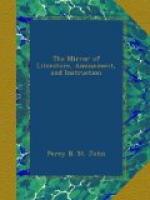Though this picture is greatly celebrated in Italy, and especially at Arezzo, I shall not pause to describe it minutely. Beatrice is represented as reclining, in a chaste and thoughtful attitude, on an antique couch at the foot of a pillar: flowers and flowering shrubs appear to shed their perfume around; and a spreading tree, with a vine loaded with grapes climbing up its trunk and branches, stretches over her. In the back ground the sky only, and a few dusky trees, appear. The design, it will be perceived is meagre enough, but the execution is incomparably beautiful; and it may be safely affirmed, that if immortality upon earth was all that Bernardo coveted for his child, his prayer has been granted. A thousand pens have been employed in celebrating this picture, and Italian literature must perish ere Beatrice be forgotten.
I shall not pretend to say by what means, since it was not by words, Spinello discovered that he was beloved by Beatrice: but assuredly the discovery gave him considerable pain. The form of Beatrice would rise up both in his sleeping and waking dreams before his fancy, among his most cherished associations; and her features, although he observed it not, mingled themselves, as it were, with the elements of every picture he painted.
While this was the state of his mind and feelings, Spinello was engaged to paint his famous picture of the “Fall of the Angels,” for the church of St. Angelo at Arezzo. The design of this great work, which has been celebrated by Vasari, Moderni, and other writers on Italian art, was at once magnificent and original; and the countenance and figure of Lucifer, upon which the artist appeared to have concentrated all the rays, as it were, of his genius, were conceived in a manner fearfully sublime. Spinello disdained the vulgar method of binding together, by an arbitrary link, all the attributes of ugliness, which artists have generally pursued when they would represent the greatest of the fallen angels; and, after meditating long upon the best mode of embodying the principle of evil, determined to clothe it with a certain form of beauty, though of a kind not calculated to delight, but on the contrary to awaken in the soul all those feelings of uneasiness, anxiety, apprehension and terror, which usually slumber in the abysses of our nature, and are disturbed only on very extraordinary occasions.
From the moment in which he began to delineate this miraculous figure, a singular change seemed to have taken place in his whole nature. His imagination, like a sea put in motion by the wind, appeared to be in perpetual agitation. He was restless and uneasy when any other occupation kept him away from his picture. As his health was good, and his frame vigorous though susceptible, this state of excitement was at first rather pleasing than otherwise. He indulged himself, therefore, with those agitating visions, as they may be called, which the contemplation or recollection of his Lucifer called up before his mind. At length, however, the idea of the mighty fallen angel, whose form he had delighted to clothe with terror and sublimity, began to present itself under a new character to his mind; and instead of being a subject to be fondled, as it were, and caressed by the imagination, seemed as it approached maturity to manifest certain mysterious qualities, which, engendered terror and apprehension rather than delight.




